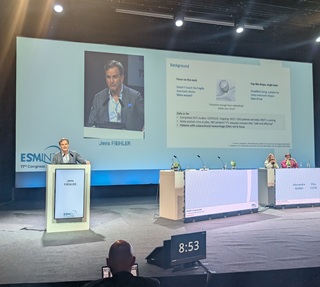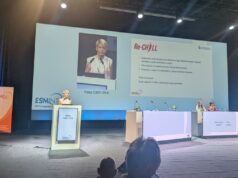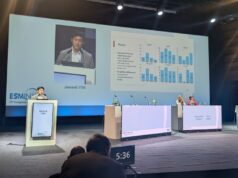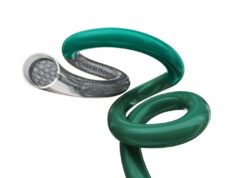
New data from the CONTRA study—presented for the first time by Jens Fiehler (University Medical Center Hamburg-Eppendorf, Hamburg, Germany) at the 2025 European Society of Minimally Invasive Neurological Therapy (ESMINT) annual congress (3–5 September, Marseille, France)—suggest that the Contour intrasaccular system (Stryker) can be safely and effectively utilised in the treatment of ruptured intracranial aneurysms.
At the outset of his presentation, Fiehler described Contour as having a “unique, cup-like shape” that simplifies device sizing and elevates its overall ease of use, also highlighting the fact that it does not touch the fragile dome of the aneurysm once deployed, potentially making treatments “more secure”. Yet, while studies to date have indicated that the device is safe and effective across an array of aneurysm cases, it remains “unclear” if it is appropriate in subarachnoid haemorrhage (SAH) treatment.
“There is some discussion over whether or not its single-layer mesh is protective enough in SAH,” Fiehler noted. “So, to answer this question, we came up with the CONTRA study evaluating Contour in the treatment of ruptured aneurysms.”
This ongoing retrospective analysis is looking at available data from centres across Europe and India, with the researchers primarily seeking to rule out any signal of poor results when treating ruptured aneurysms with Contour. Their key effectiveness endpoint was the rate of complete occlusion (Raymond-Roy occlusion classification [RROC] 1) without retreatment of the target aneurysm after the initial therapy, and without recurrent SAH associated with the target aneurysm at one year post-index procedure. Their primary safety endpoint consisted of death or stroke within 30 days of the index treatment, or ipsilateral stroke or neurological death between 30 days and one year.
The interim data presented by Fiehler at ESMINT 2025 were derived from the first four centres participating in the CONTRA study—with a total of 11 ultimately planned.
“One thing we also used for the first time in this study was the so-called MACAO classification, which attempts to analyse and describe the device positioning and stability in a very simple way,” he added.
Arriving at the results, Fiehler reported that he and his colleagues analysed 53 patients with 53 aneurysms—87% of which were ‘berry-shaped’, with the remaining 13% being more complex—and observed only one case (1.9%) of rebleeding across 12 months of follow-up.
He went on to note that the picture regarding occlusion rates was “a bit complicated”, because assessable, core lab-adjudicated follow-up data were only available in 19 patients (36%), partially due to four cases in which an RROC score could not be determined. Nevertheless, the presenter relayed complete occlusion rates that are “quite encouraging”, ranging from 25% immediately after the procedure and 52% at discharge to an average of 68% at the latest available follow-up timepoint—with the latter figure being “much higher than we expected”, albeit across a limited number of patients, according to Fiehler. He also briefly highlighted adequate occlusion (RROC 1 or 2) rates of 38% post-procedure, 71% at discharge, and 95% at the latest available follow-up.
“What we can conclude from the data at this point is that there are no suggestions of any poor outcomes in ruptured aneurysm patients,” Fiehler stated, also positing that these findings support further exploration of the Contour device in SAH. “I wouldn’t say it’s brilliant, because of the limited numbers, but we have no signal whatsoever that it doesn’t work in these cases. I think we can almost exclude that.”
Providing two further concluding messages, Fiehler added that the CONTRA study has—thus far—demonstrated no significant differences in outcomes when Contour is utilised as a standalone device versus in conjunction with embolisation coils, before also highlighting the fact that the MACAO classification revealed associations between occlusion outcomes and initial neck coverage, as well as deployment axis. Expanding on the second of these points, he stated that ‘good’ neck coverage was linked to an occlusion rate of 85% versus just 40–50% with poorer neck coverage—a “surprisingly big” effect size, in Fiehler’s view—while a ‘tilt’ between the device and the aneurysm’s axial lining appeared to reduce the occlusion rate to 29% compared to 92% with no tilt.
“This makes a lot of sense when you think about the geometry of the Contour device,” he said, “and it’s encouraging that this classification seems to make sense too.”










